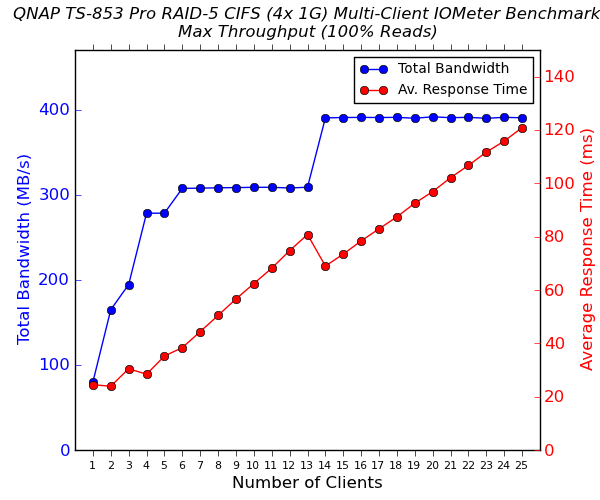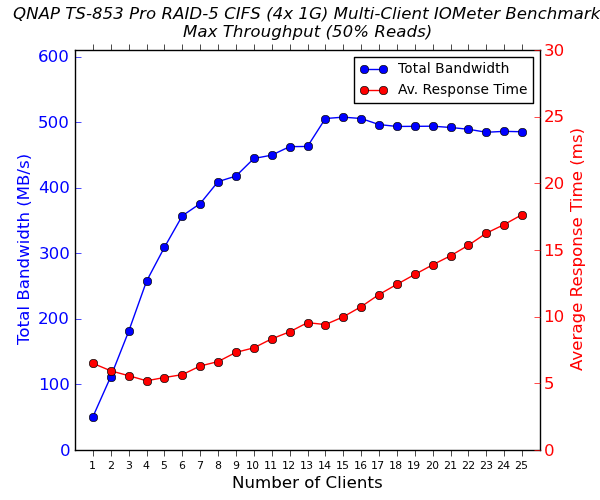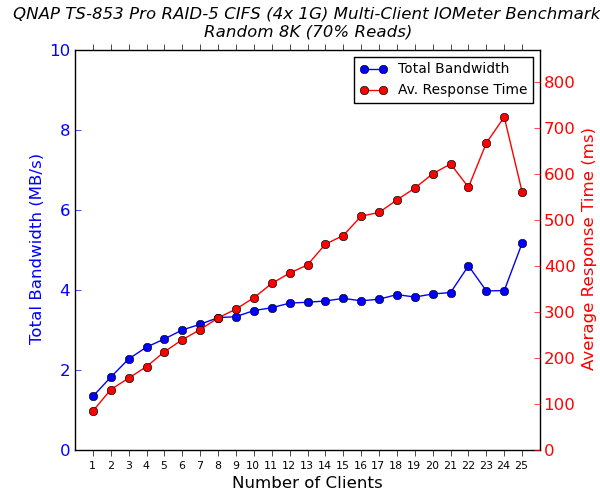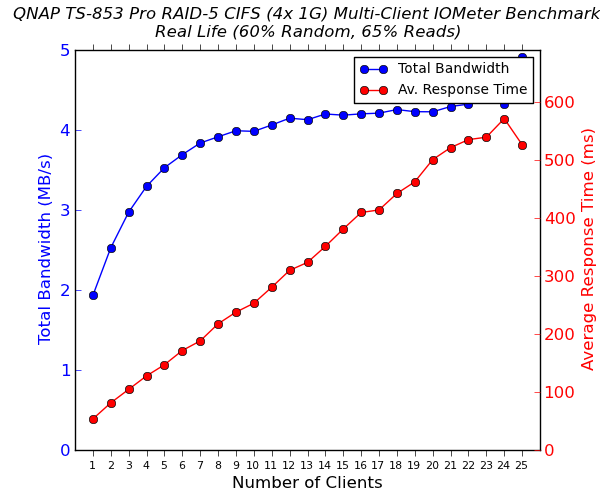QNAP TS-853 Pro 8-bay Intel Bay Trail SMB NAS Review
by Ganesh T S on December 29, 2014 7:30 AM ESTMulti-Client Performance - CIFS on Windows
We put the QNAP TS-853 Pro through some IOMeter tests with a CIFS share being accessed from up to 25 VMs simultaneously. The following four graphs show the total available bandwidth and the average response time while being subject to different types of workloads through IOMeter. The tool also reports various other metrics of interest such as maximum response time, read and write IOPS, separate read and write bandwidth figures etc. Detailed listings of the IOMeter benchmark numbers (including IOPS and maximum response times) for each configuration are linked below:
- QNAP TS-853 Pro - 8 HDDs / RAID-5 - 4x 1G
- QNAP TS-853 Pro - 8 HDDs / RAID-5 - 2 VMs / 2x 1G
- QNAP TS-853 Pro - 8 HDDs / RAID-5 - 1 QVM / 2x 1G




The important aspect to note here is that the performance for the random workloads when the VMs are active are all over the place, following no particular pattern. This is due to the fact that the PC Mark 8 'Work' workload running in the background doesn't uniformly load the system resources. It is sufficient to observe that even moderately heavy word processing or similar task can pull down the NAS performance for certain types of workloads.
In the absence of active VMs, enabling link aggregation with all four ports allows maximum throughput numbers in the order of 400+ MBps for pure read workloads.










58 Comments
View All Comments
lorribot - Monday, December 29, 2014 - link
Two things strike me $210 for 8GB ram, how can anyone justify that? Even Apple aren't that expensive.Raid 5 really? With 4TB SATA disks if you are going to bother with rundundancy then raid 6 please. from painful experience Raid 5 no longer cuts the mustard for protection given SATA's poor data verification and the huge rebuild time on a 4TB based array I really wouldn't bother, if you data is that important then you need to be backing up the changes or use a proper storage syatem.
Pro NAS boxes like these are overpriced for what they offer, which in reality is not a lot, as for running a VMs off of it I personally wouldn't bother.
Halve the price and offer some form of asyncronous replcation and you may just be on to something.
As it is one of HP's micro servers with a bunch of disks in it would offer better value.
mhaubr2 - Monday, December 29, 2014 - link
Seriously not trolling here - trying to better understand. Coming from the original Windows Home Server and its Drive Pool concept has me spoiled. I'm now using WHS2011 and Drive Bender, and it seems like the way to go. With pooled drives I can expand capacity easily using mix-and-match drives of different brands, sizes and vintages. This seems far less risky than using 3 or more identical drives in a RAID-5 or 6 array. I don't have to worry about getting a bad batch of drives or having a second (or third) drive fail on rebuild. This is how I see it, but I know there are plenty of folks out there that are proponents of RAID-x. I'm looking to build a new media server, so why should I consider a RAID setup over drive pooling?PEJUman - Monday, December 29, 2014 - link
I actually have the same thought process as you. but my mindset was setup around a single family file server demands. where the single drive with duplication would be sufficient in terms of performance/reliabilty. The Raid arrays allows much higher theoretical performance compared to Drive Bender's, not to mention better than N/2 efficiency for single disk failure tolerance.I personally like Drive Bender's solution for my needs, but will not use it for business oriented needs: 100% uptime, high performance and multi disk failure tolerant setup.
DanNeely - Tuesday, December 30, 2014 - link
Between long rebuild times and the risk of an URE bringing down the array, RAID10 (or it's equivalents) have largely replaced RAID5/6 in larger arrays and SANs.DanNeely - Tuesday, December 30, 2014 - link
FWIW I'm running WHS2011 but with DrivePool instead. Quite happy with it so far, but it's only 16 months until end of life; and with the WHS series seemingly dead as well I've been paying closer attention to the rest of the nas world hoping to find a suitable replacement. So far without much luck.ZFS seems like it's the closest option; but unless I've missed something (or newer features have been added since the blogs/etc that I've read) options for expanding are limited to: Swapping out all the drives one at a time for larger ones rebuilding each time and only getting more usable space after all the drives have been replaced; or by adding a minimum of two drives (in a raid1 analog) as a separate sub array.
Aside from Drobo, which has recovery issues due to its proprietary FS (no option to pull drives and stick into a normal PC to get data off if it goes down) and is reported to slow down severely at it fills to near capacity, I'm not aware of anything else on the market that would allow for creating and expanding a mirrored storage pool out of mismatched disks the way WHSv1 did or WHS2011 does with 3rd party disk management addons.
Brett Howse - Tuesday, December 30, 2014 - link
If you are happy with WHS 2011 (that's what I run too) you may want to check out Storage Spaces in Windows 8/8.1 and Server 2012/2012 R2.http://technet.microsoft.com/en-us/library/hh83173...
It's like WHS v1's drive extender but done right. You can do mirror or parity to one or more drives, as well as mix and match the drives including SSDs for different speed tiers. Might be worth your time to check out.
Because this is all available on Windows 8.1, you can do it for a low cost compared to buying Windows Server. What you'd lose though (and this is why I haven't moved off WHS yet) is the amazing full device backup that WHS offers. This is only available in Windows Server Essentials as far as I know, which is a big licensing fee compared to what WHS used to retail for.
Gigaplex - Wednesday, December 31, 2014 - link
It's not done right. If you have a parity pool and add one more drive later, well, you can't. If you started with 3 drives, the only way to expand is to add 3 drives at a time.jabber - Tuesday, December 30, 2014 - link
Why do folks keep bleating on about RAID5? It's been classed as obsolete for nearly 5 years.Move on folks.
fackamato - Friday, January 2, 2015 - link
Because it's still applicable for small drives e.g. SSD's or sub-2TB.chocosmith - Tuesday, December 30, 2014 - link
i have the ts-453 pro, as a nas its great but i also got it for the hdmi so i could kill two birds with one stone and use it as a media box.unforuntately there is a huge amount of video tearing and the power supply fan is too loud for it to hang near the tv. overall if i was doing it again i'd simply get a celeron chip a small case and build it myself, i'd also probably use windows.
also as others noted with the raid setup. After failing a raid 1 during rebuild i now simply use no raid. one disk can flood a 1gb lan so speed isn't an issue.
Instead i just have the two disk, one is shared the other isn't. At 2am every morning i copy the changed files to the other. this gives me also some "opppp i deleted something" breathing space. I don't need critical raid.
my primary is a ssd, its also used for torrents and other chatty stuff